ESP Lexus GS350 2016 Repair Manual
[x] Cancel search | Manufacturer: LEXUS, Model Year: 2016, Model line: GS350, Model: Lexus GS350 2016Pages: 624, PDF Size: 15.29 MB
Page 526 of 624
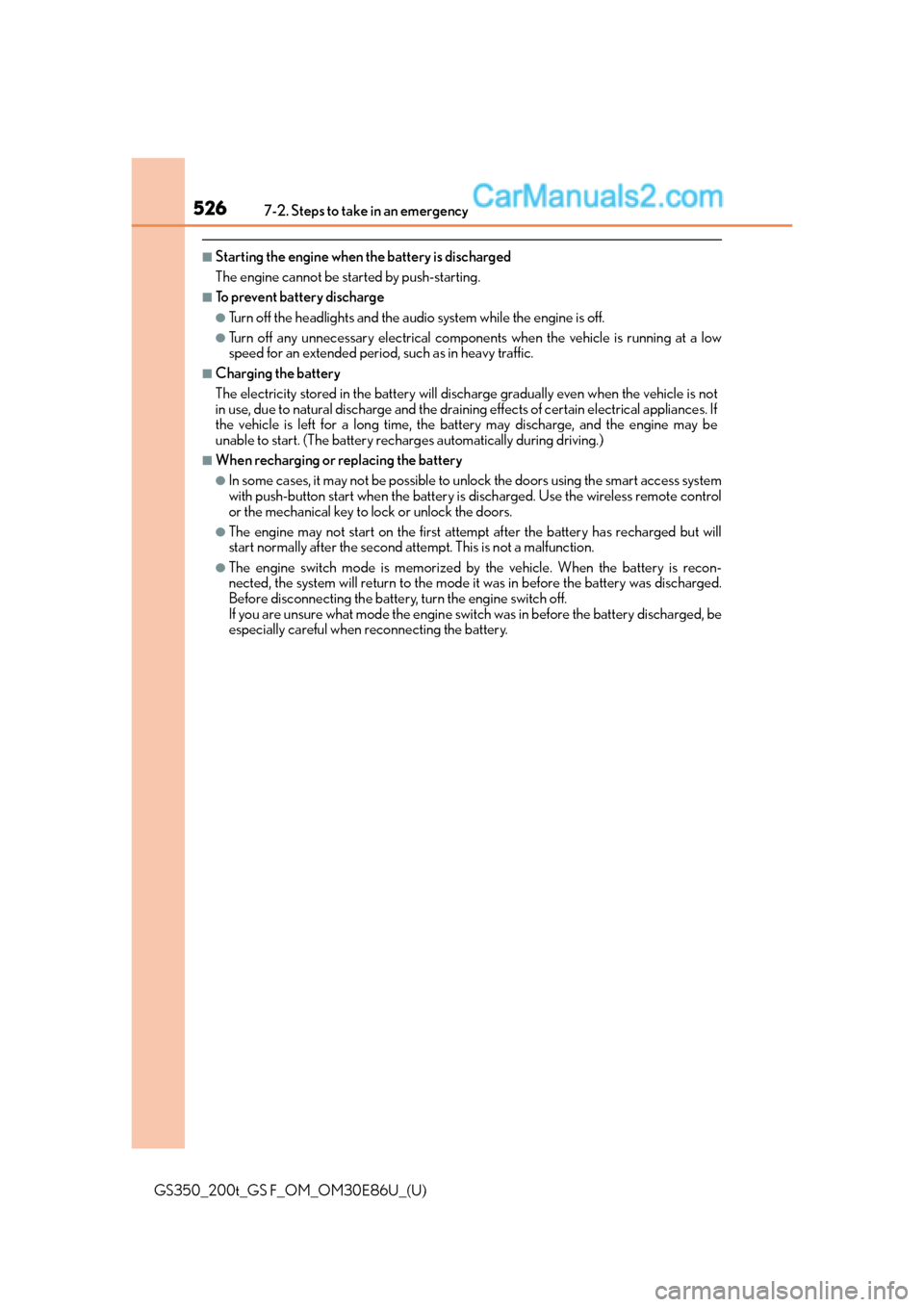
5267-2. Steps to take in an emergency
GS350_200t_GS F_OM_OM30E86U_(U)
■Starting the engine when the battery is discharged
The engine cannot be started by push-starting.
■To prevent battery discharge
●Turn off the headlights and the audio system while the engine is off.
●Turn off any unnecessary electrical components when the vehicle is running at a low
speed for an extended period, such as in heavy traffic.
■Charging the battery
The electricity stored in the battery will discharge gradually even when the vehicle is not
in use, due to natural discharge and the draining effects of certain electrical appliances. If
the vehicle is left for a long time, the battery may discharge, and the engine may be
unable to start. (The battery recharges automatically during driving.)
■When recharging or replacing the battery
●In some cases, it may not be possible to unlock the doors using the smart access system
with push-button start when the battery is discharged. Use the wireless remote control
or the mechanical key to lock or unlock the doors.
●The engine may not start on the first attempt after the battery has recharged but will
start normally after the second attempt. This is not a malfunction.
●The engine switch mode is memorized by the vehicle. When the battery is recon-
nected, the system will return to the mode it was in before the battery was discharged.
Before disconnecting the battery, turn the engine switch off.
If you are unsure what mode the engine switch was in before the battery discharged, be
especially careful when reconnecting the battery.
Page 532 of 624
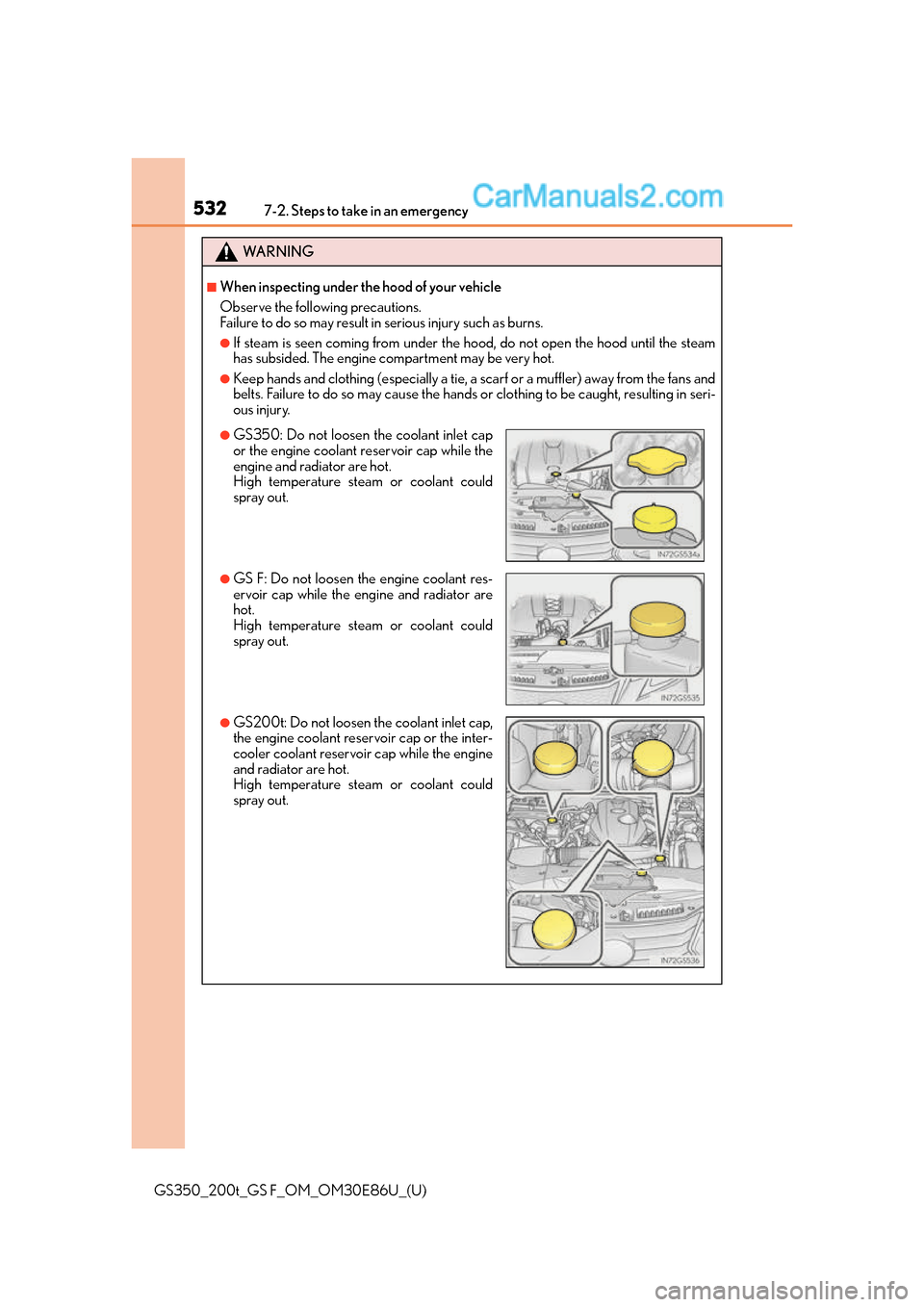
5327-2. Steps to take in an emergency
GS350_200t_GS F_OM_OM30E86U_(U)
WA R N I N G
■When inspecting under the hood of your vehicle
Observe the following precautions.
Failure to do so may result in serious injury such as burns.
●If steam is seen coming from under the hood, do not open the hood until the steam
has subsided. The engine compartment may be very hot.
●Keep hands and clothing (especially a tie, a scarf or a muffler) away from the fans and
belts. Failure to do so may cause the hands or clothing to be caught, resulting in seri-
ous injury.
●GS350: Do not loosen the coolant inlet cap
or the engine coolant reservoir cap while the
engine and radiator are hot.
High temperature steam or coolant could
spray out.
●GS F: Do not loosen the engine coolant res-
ervoir cap while the engine and radiator are
hot.
High temperature steam or coolant could
spray out.
●GS200t: Do not loosen the coolant inlet cap,
the engine coolant reservoir cap or the inter-
cooler coolant reservoir cap while the engine
and radiator are hot.
High temperature steam or coolant could
spray out.
Page 563 of 624
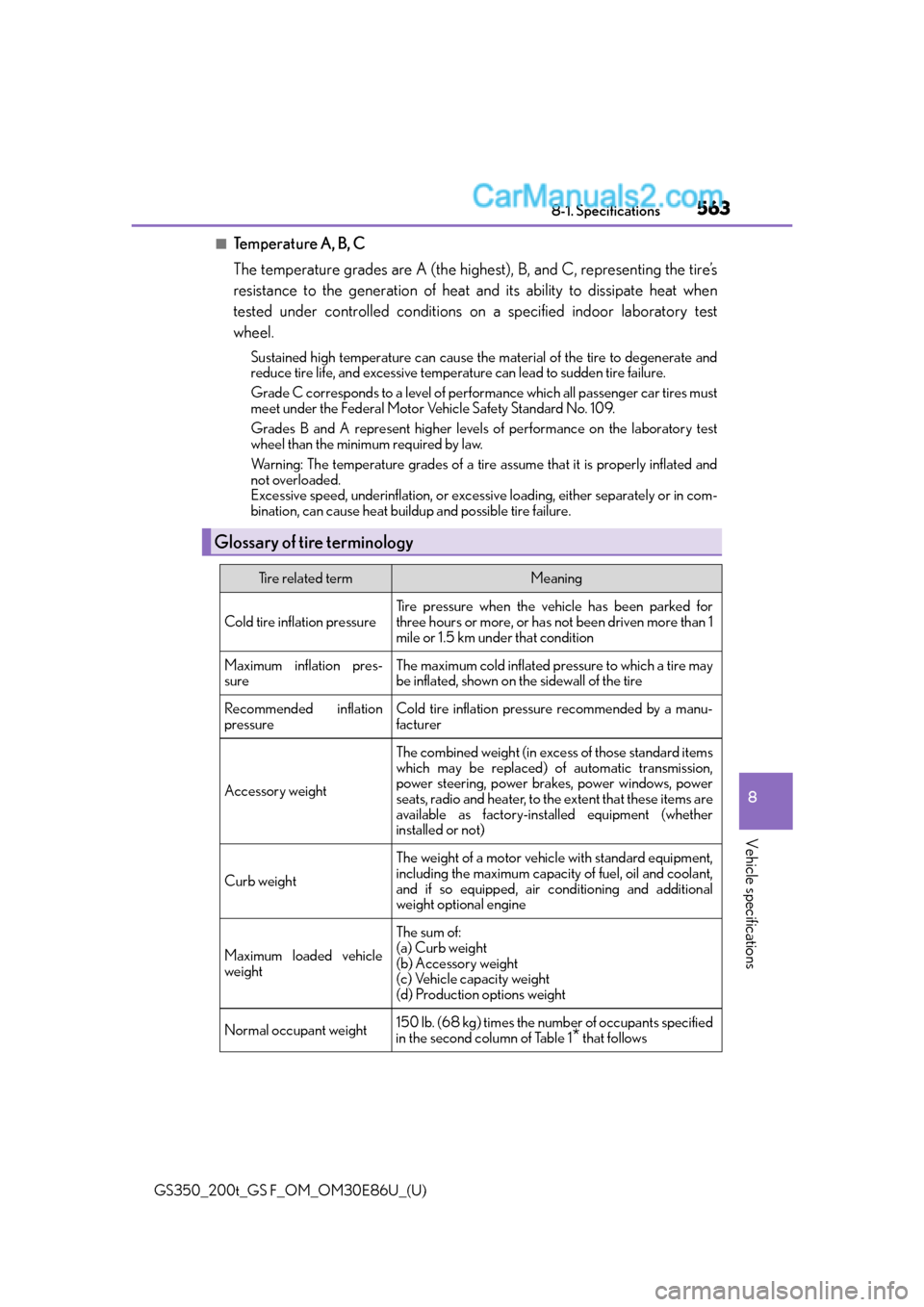
GS350_200t_GS F_OM_OM30E86U_(U)
5638-1. Specifications
8
Vehicle specifications
■Temperature A, B, C
The temperature grades are A (the highest), B, and C, representing the tire’s
resistance to the generation of heat and its ability to dissipate heat when
tested under controlled conditions on a specified indoor laboratory test
wheel.
Sustained high temperature can cause the material of the tire to degenerate and
reduce tire life, and excessive temperature can lead to sudden tire failure.
Grade C corresponds to a level of perfor mance which all passenger car tires must
meet under the Federal Motor Vehicle Safety Standard No. 109.
Grades B and A represent higher levels of performance on the laboratory test
wheel than the minimum required by law.
Warning: The temperature grades of a tire assume that it is properly inflated and
not overloaded.
Excessive speed, underinflation, or excessiv e loading, either separately or in com-
bination, can cause heat buildup and possible tire failure.
Glossary of tire terminology
Tire related termMeaning
Cold tire inflation pressure
Tire pressure when the vehicle has been parked for
three hours or more, or has not been driven more than 1
mile or 1.5 km un der that condition
Maximum inflation pres-
sureThe maximum cold inflated pressure to which a tire may
be inflated, shown on the sidewall of the tire
Recommended inflation
pressureCold tire inflation pressure recommended by a manu-
facturer
Accessory weight
The combined weight (in excess of those standard items
which may be replaced) of automatic transmission,
power steering, power brakes, power windows, power
seats, radio and heater, to the extent that these items are
available as factory-installed equipment (whether
installed or not)
Curb weight
The weight of a motor vehicle with standard equipment,
including the maximum capacity of fuel, oil and coolant,
and if so equipped, air co nditioning and additional
weight optional engine
Maximum loaded vehicle
weight
The sum of:
(a) Curb weight
(b) Accessory weight
(c) Vehicle capacity weight
(d) Production options weight
Normal occupant weight150 lb. (68 kg) times the numb er of occupants specified
in the second column of Table 1
* that follows
Page 565 of 624
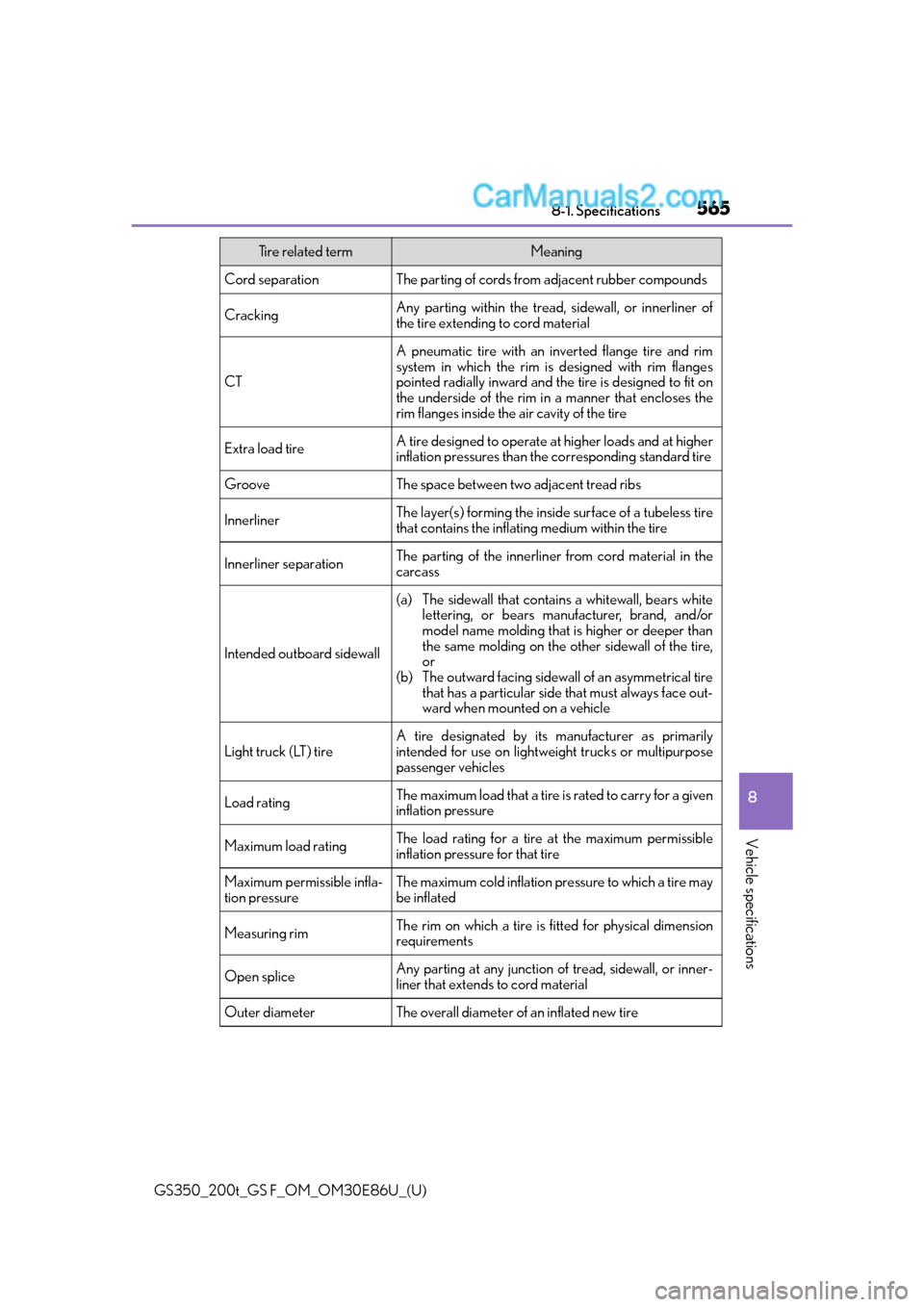
GS350_200t_GS F_OM_OM30E86U_(U)
5658-1. Specifications
8
Vehicle specifications
Cord separationThe parting of cords from adjacent rubber compounds
CrackingAny parting within the tread, sidewall, or innerliner of
the tire extending to cord material
CT
A pneumatic tire with an inverted flange tire and rim
system in which the rim is designed with rim flanges
pointed radially inward and the tire is designed to fit on
the underside of the rim in a manner that encloses the
rim flanges inside the air cavity of the tire
Extra load tireA tire designed to operate at higher loads and at higher
inflation pressures than the corresponding standard tire
GrooveThe space between two adjacent tread ribs
InnerlinerThe layer(s) forming the inside surface of a tubeless tire
that contains the inflating medium within the tire
Innerliner separationThe parting of the i nnerliner from cord material in the
carcass
Intended outboard sidewall
(a) The sidewall that contains a whitewall, bears white lettering, or bears manufacturer, brand, and/or
model name molding that is higher or deeper than
the same molding on the ot her sidewall of the tire,
or
(b) The outward facing sidewall of an asymmetrical tire
that has a particular side that must always face out-
ward when mounted on a vehicle
Light truck (LT) tireA tire designated by its manufacturer as primarily
intended for use on lightweight trucks or multipurpose
passenger vehicles
Load ratingThe maximum load that a tire is rated to carry for a given
inflation pressure
Maximum load ratingThe load rating for a tire at the maximum permissible
inflation pressure for that tire
Maximum permissible infla-
tion pressureThe maximum cold inflation pressure to which a tire may
be inflated
Measuring rimThe rim on which a tire is fitted for physical dimension
requirements
Open spliceAny parting at any junction of tread, sidewall, or inner-
liner that extends to cord material
Outer diameterThe overall diameter of an inflated new tire
Tire related termMeaning
Page 566 of 624
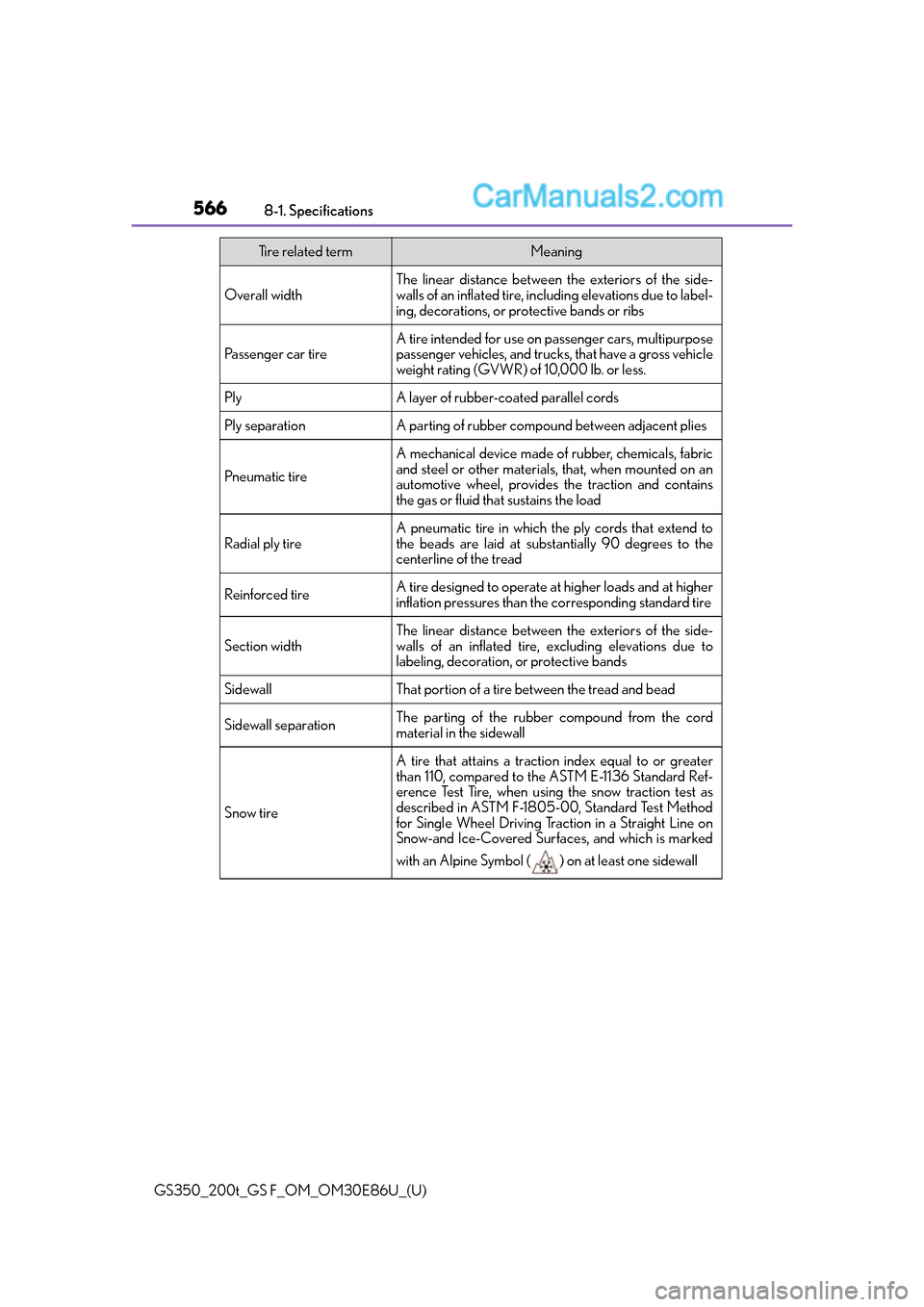
566
GS350_200t_GS F_OM_OM30E86U_(U)8-1. Specifications
Overall widthThe linear distance between the exteriors of the side-
walls of an inflated tire, incl
uding elevations due to label-
ing, decorations, or pr otective bands or ribs
Passenger car tire
A tire intended for use on passenger cars, multipurpose
passenger vehicles, and trucks, that have a gross vehicle
weight rating (GVWR) of 10,000 lb. or less.
PlyA layer of rubber-coated parallel cords
Ply separationA parting of rubber compound between adjacent plies
Pneumatic tire
A mechanical device made of rubber, chemicals, fabric
and steel or other materials, that, when mounted on an
automotive wheel, provides the traction and contains
the gas or fluid that sustains the load
Radial ply tire
A pneumatic tire in which the ply cords that extend to
the beads are laid at substantially 90 degrees to the
centerline of the tread
Reinforced tire A tire designed to operate at higher loads and at higher
inflation pressures than the corresponding standard tire
Section width
The linear distance between the exteriors of the side-
walls of an inflated tire, excluding elevations due to
labeling, decoration, or protective bands
SidewallThat portion of a tire between the tread and bead
Sidewall separationThe parting of the rubber compound from the cord
material in the sidewall
Snow tire
A tire that attains a traction index equal to or greater
than 110, compared to the ASTM E-1136 Standard Ref-
erence Test Tire, when using the snow traction test as
described in ASTM F-1805-00, Standard Test Method
for Single Wheel Driving Tract ion in a Straight Line on
Snow-and Ice-Covered Surfaces, and which is marked
with an Alpine Symbol ( ) on at least one sidewall
Tire related termMeaning
Page 595 of 624

GS350_200t_GS F_OM_OM30E86U_(U)
595
9
For owners
AVERTISSEMENT
■Précautions relatives aux coussins gonflables SRS
●N’accrochez pas de cintres ni d’autres objets rigides sur les crochets porte-vête-
ments. Tous ces objets pour raient se transformer en projectiles et vous occasionner
des blessures graves, voire mortelles, en cas de déploiement des coussins gonflables
SRS en rideau.
●Si un recouvrement de vinyle est placé su r la zone de déploiement du coussin gon-
flable SRS de protection des genoux, veillez à le retirer.
●N’utilisez pas d’accessoires recouvrant les pa rties du siège où les coussins gonflables
SRS latéraux se déploient, car ces access oires pourraient entraver le déploiement
des coussins gonflables. De tels accessoires peuvent empêcher les coussins gon-
flables latéraux de se déployer correctement, rendre le système inopérant ou provo-
quer accidentellement le déploiement des coussins gonflables latéraux,
occasionnant des blessures graves, voire mortelles.
●Ne frappez pas et n’appliquez pas une pr ession importante à l’emplacement des
composants des coussins gonflables SRS.
Cela peut provoquer un mauvais foncti onnement des coussins gonflables SRS.
●Ne touchez à aucun composant des coussins gonflables SRS immédiatement après
leur déploiement (gonflage), car ils pourraient être chauds.
●Si vous avez de la difficulté à respirer après le déploiement des coussins gonflables
SRS, ouvrez une portière ou une glace pour laisser entrer l’air, ou quittez le véhicule
si vous pouvez le faire en toute sécurité. Dès que possible, nettoyez tous les résidus
afin d’éviter les irritations cutanées.
●Si les emplacements de stockage des coussi ns gonflables SRS, tels que le tampon de
volant, la porte de la boîte à gants et les ga rnitures des montants avant et arrière, sont
endommagés ou fissurés, faites-les re mplacer par votre concessionnaire Lexus.
●Ne placez aucun objet, par exemple un coussin, sur le siège du passager avant. Cela
disperserait le poids du passager, ce qui empêcherait le capteur de le détecter cor-
rectement. Cela pourrait empêcher le déploiement des coussins gonflables SRS du
passager avant en cas de collision.